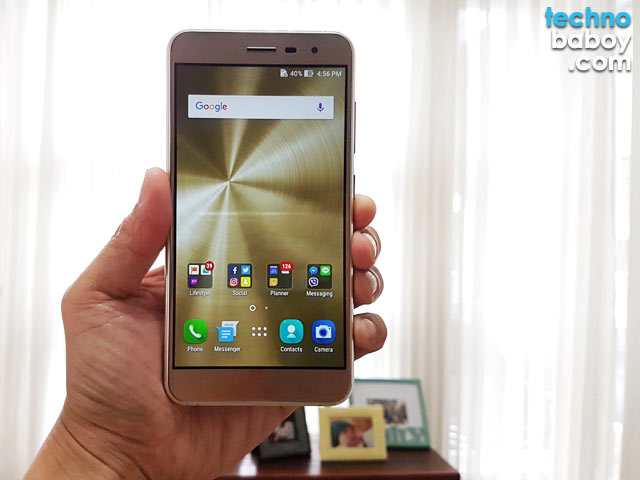Launched last August 2016, the ASUS ZenFone 3 is the successor of last year’s hit, ZenFone 3. This year’s darling comes in two flavors — a 5.2-inch and a 5.5-inch variant. Today, we take a look at the 5.5-inch ASUS ZenFone 3 ZE552KL.
ASUS ZenFone 3 Review
Before we start with the review, let’s take a quick look at what makes the ASUS ZenFone 3 tick. The smartphone comes with 5.5-inch display that uses Super IPS technology with a full HD 1920 by 1080 resolution and a pixel density of 401ppi. Under the hood is a 2 GHz octa-core Qualcomm Snapdragon 625 processor, an Adreno 506 graphics chip and 4 GB of RAM. The PixelMaster 3 camera uses a Sony IMX298 sensor while the front camera uses an 8MP sensor. It has a fingerprint sensor, a USB Type-C port and a large 3,000 mAh battery.
ASUS ZenFone 3 ZE552KL key specs:
- 5.5-inch Super IPS+ Full HD Display (1920 x 1080; 401ppi)
- 2.5D Corning Gorilla Glass 3
- 2GHz Octa-core Qualcomm Snapdragon 625 Processor
- Adreno 506 GPU
- 4GB RAM
- 64GB Storage +microSD via Hybrid SIM Slot
- 16MP Main Camera with Sony IMX298 sensor, PixelMaster 3, F/2.0, Dual-Tone Flash, OIS + EIS
- ASUS TriTech Autofocus System (2nd Gen Laser AF, Phase Detection AF, Continuous AF)
- 8MP Front Camera
- Dual SIM (Hybrid Slot for SD Card)
- Cat 6 LTE
- Wi-Fi 802.11ac MU-MIMO
- Bluetooth v4.2
- USB Type-C Port with USB 2.0 connectivity
- Fingerprint sensor
- Android 6.0 Marshmallow with ASUS ZenUI 3.0
- 3,000mAh Non-removable Battery
- Colors: Sapphire Black, Moonlight White, Shimmer Gold
- P18,995
Retail Package
The ASUS ZenFone 3 comes in a new premium looking black box with gold lettering emblazoned in front. Inside, you’ll find the ZenFone 3 and the usual list of accessories – a fast travel charger, a USB Type-C cable, a SIM Ejector Tool, documentation and a set of earbuds.
Design
Our review unit is the 5.5-inch ZE552KL model in Shimmer Gold. And I must say, it is beautiful. The smartphone has a new design and a very premium vibe. Departing from the ZenFone 2’s curved back and plastic build, this year’s model has a thin and clean profile, subtle curved edges, and a glass-metal-glass build.
In the hand, the smartphone feels great. The build quality is fantastic. It is solid and light, and the thin bezels keep it from being unwieldy.
Despite the great design, there are some issues that need to be sorted out. First, the same glass-metal-glass build that made this smartphone look so elegant also made it slippery and prone to fingerprints. It’s not that big a deal for me (because I always use a case) but it’s something to keep in mind.
Second is the slight camera bump. It juts out a few millimeters from the back panel and touches the surface its placed on. But it should be nothing to worry about because its protected by scratch resistant sapphire glass.
And third, the ZenFone 3 uses capacitive keys for back, home and app switching. While the move increased the screen real estate by a few pixels, I think it would have been better if the keys are backlighted. There are times where I was fumbling for them in the dark.
Display
The ZenFone 3 uses a 5.5-inch Super IPS display with a full HD resolution of 1920 by 1080 and an eye popping 401 ppi pixel density. The display is bright, with good color saturation and ample sharpness. Viewing angles are great, with acceptable legibility in direct sunlight.
Performance and Benchmarks
Powering the ZenFone 3 is a 2 GHz octa-core Qualcomm Snapdragon 625 processor coupled with an Adreno 506 graphics chip and 4 GB of RAM. The specs are mid-range, but it should be more than enough for day to day tasks.
To test it, I ran a couple of benchmark apps to highlight what it’s capable of. With AnTuTu Benchmark, the phone managed to score 62,696 points. In Geekbench 4, it got a score of 831 points in Single-Core, and 4,028 on the Multi-Core. The scores are on par with mid-range devices, but I feel compelled to inform people not to put too much into it.
In terms of actual performance, the ZenFone 3 runs great. It is fast and snappy, and very smooth. The device is very responsive, and there is little to no lag. The only time I have some semblance of lag was when I was using the camera app, but it seems to have been fixed by a recent update.
Fingerprint Sensor
Like most phones of 2016, the ZenFone 3 now comes with a pill-shaped fingerprint sensor placed at the back of the device underneath the camera. It is fast and accurate, and can unlock the device quickly. It also works on fingerprint enabled apps like Google Play and the BPI App. One drawback though is that ASUS tied the fingerprint sensor with the ZenUI Launcher, meaning it won’t work or unlock the device if you install another launcher and give that same launcher device administration control over locking your device.
Battery Life
The ZenFone 3 packs a 3,000 mAh battery with fast charging. As my daily driver, I managed to last me a day with mixed medium to heavy usage that includes browsing the web and social media apps, watching videos on YouTube watching, and playing games. I also sync my Fitbit Alta via Bluetooth from time to time. Theoretically, it should last longer with light usage.
Camera
The ZenFone 3 is equipped with a 16MP PixelMaster 3 camera with a Sony IMX298 sensor. It has a wide f/2.0 aperture, dual-tone flash, and ASUS’ TriTech Autofocus System (which is a combination of the 2nd Gen Laser AF, PDAF and Continuous AF).
On default auto settings, the ZenFone 3 is capable of generating good photos with punchy colors and reasonable sharpness in good lighting conditions. You can tweak it further by digging into the settings, but I generally find that the default setting is sufficient for most people.
Autofocus is fast and acceptable. The Tritech Autofocus System does a good job, especially in good lighting conditions. But it does hunt and slow down a bit in low light.
The front camera uses an 8MP sensor, and is good enough for the occasional selfie for Instagram and Facebook.
Conclusion: Highly Recommended
All in all, I am very pleased and impressed with the ASUS ZenFone 3 ZE552KL. It is a definite improvement over its predecessor. It comes with a beautiful new design, good performance, and an impressive battery life. Its not perfect mind you, but it does a lot of things right to warrant a recommendation.
The ASUS ZenFone 3 ZE552KL retails for P18,995. I know that the price turned a few heads when it was announced, but the upgrades are worth it.
For more tech-centric news and reviews, please follow us on Facebook (facebook.com/TechnoBaboy), YouTube (TechnoBryan) and Twitter (@technobaboy). We’ll do our best to keep you up-to-date.



















1 Comment
– baLigya na piLa sad na sia ?